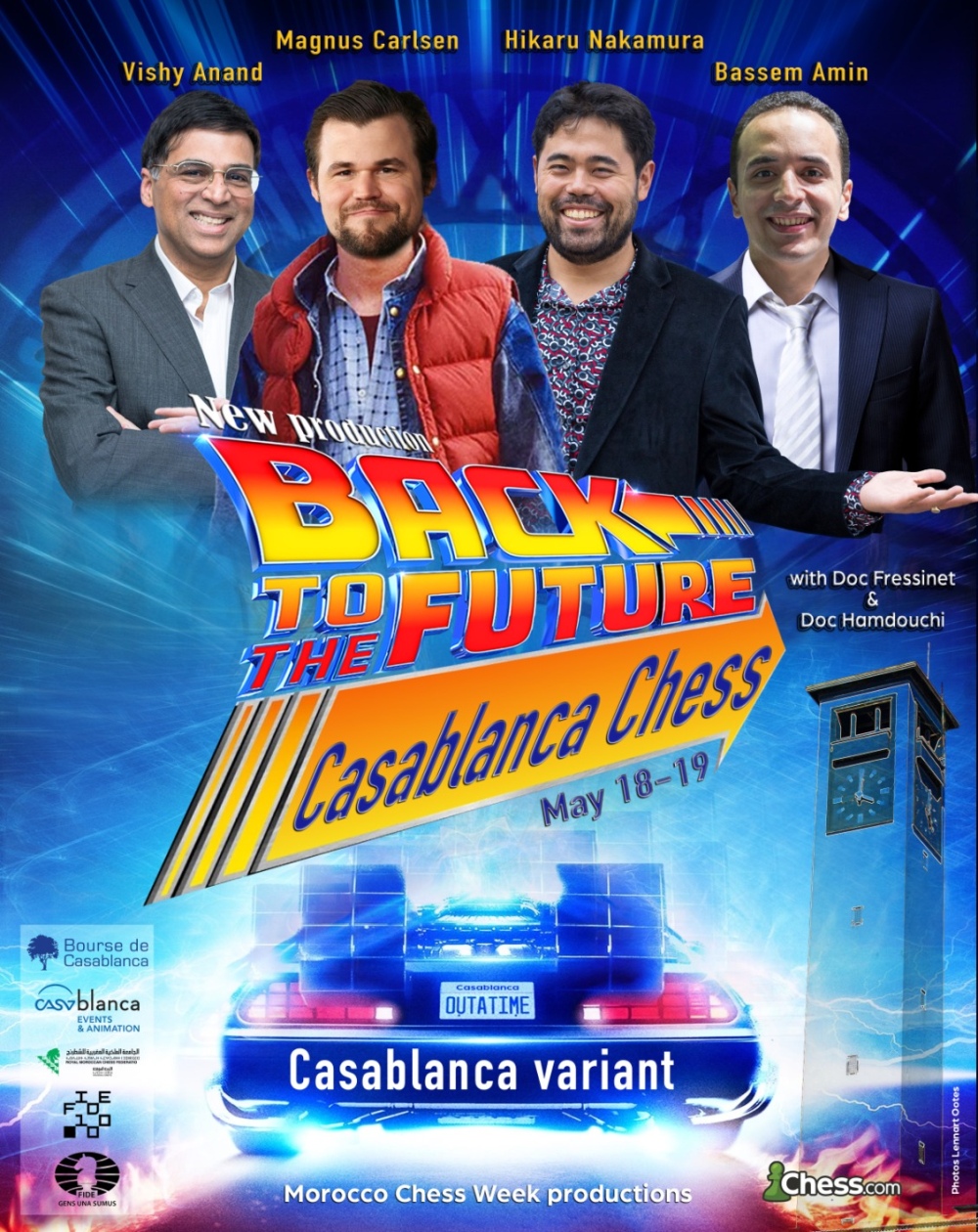
By GM Hicham Hamdouchi and GM Laurent Fressinet
This weekend, the grand chess spectacle will begin in Morocco. Four top grandmasters – Carlsen, Nakamura, Anand, and Amin – will test the new Casablanca Chess Variant, introduced by the Casablanca Stock Exchange. They will start their rapid games from carefully selected positions derived from historical games. The idea of this innovative format was suggested by Tarik Senhaji, CEO of Casablanca Stock Exchange.
The schedule will be as follows (all times are local):
Saturday, May 18
Round 1 at 4:15 pm / Carlsen vs Anand & Nakamura vs Amin
Round 2 at 5:30 pm / Amin vs Carlsen & Anand vs Nakamura
Round 3 at 6:45 pm / Nakamura vs Carlsen & Amin vs Anand
Sunday, May 19
Round 4 at 7:15 pm / Anand vs Carlsen & Amin vs Nakamura
Round 5 at 8:30 pm / Carlsen vs Amin & Nakamura vs Anand
Round 6 at 9:45 pm / Carlsen vs Nakamura & Anand vs Amin
The event will be broadcast live on chess.com. Each round will be preceded by a 15-minute segment dedicated to the selection of the position, either with a guest or via online polls.
At the beginning of each round, the players will receive the scoresheets of the chosen position. They will have two minutes to play through the historical game on the board up to the position from which their game will commence. Subsequently, the arbiter will initiate the clocks.
The time control will be 15 minutes with a 10-second increment. No draw offers will be permitted.
Context
There have already been themed tournaments in history, for example, starting with a position from the Buenos Aires or Najdorf variation. Alternative formats have been attempted, such as Bobby Fischer’s Chess960, Anti Chess, Crazy House, or even No Castling in Dortmund (where castling is prohibited). The objective is always the same: to break away from the well-trodden path and offer new horizons to players. Among these, only Chess960 resembles “real chess” in terms of traditional rules and enjoys relative success. The most recent experience to date was the Weissenhaus tournament in Germany, which brought together the world’s top players at classical time controls. It saw Carlsen’s victory. Unanimously, the invited top GMs were delighted with this format. It is true that Chess960 allows for more creativity. Players find themselves immediately in unfamiliar territory and try, not without difficulty, to fall back on classic and familiar patterns.
The Casablanca Variant
Now, let’s delve into the technical aspects of the Casablanca Variant. The idea is quite different. We stay within the realm of classical chess. Players are given a position from a game that has already been played (or could also be imagined). However, this position must meet several well-defined criteria. First and foremost, the evaluation should be roughly equal (around 0.00, according to engines). The position must be taken from the opening, somewhere between the 6th and 15th moves (although mainly between the 10th and 12th). Most importantly, and this is the most crucial criterion, it must offer rich possibilities for both players. As you may have guessed, the main idea is to have exciting games or, at the very least, encourage the participants to produce them. We will have the opportunity and privilege of having a royal line-up to test this idea (Magnus Carlsen, Hikaru Nakamura, Viswanathan Anand, and Bassem Amin). The positions will be carefully chosen by us (GM Hicham Hamdouchi and GM Laurent Fressinet). The event coincides with the centenary celebrations of FIDE. To further engage the audience, each position will be chosen from a historically significant game.
Let’s look at a concrete example:

Will Magnus Carlsen choose 14…Rc8?
This game was played between Nona Gaprindashvili and Maia Chiburdanidze during their Women’s World Championship match in 1978. It is the 14th round, and the position arises from a Caro-Kann defence after the White’s fourteenth move 14.Rh4. The analysis module sanctions it with an even evaluation 0.00. The most played moves for Black in the database are in the following order: 14…Be7, 14…Rc8, 14…cxd4, and 14…0-0-0.
Which strategy to choose? We can easily deduce that the position is rich in possibilities for both sides. We can see the potential opposite-side castling, a white pawn majority on the queenside, as well as other likely imbalances depending on the chosen plan by both sides. In the actual game, Maia chose 14…Rc8. The players quickly transitioned into an endgame in which Black missed a win, settling for a draw on the move 52. One game later, Maia Chiburdanidze was crowned world champion!
No preparation possible, unless…
It is in this state of mind that we have chosen a total of 18 positions (6×3=18). Before the start of every round, the position players will face off and will be picked out of possible three. After each game, it will be interesting to test the memory and encyclopaedic knowledge of our champions to see if they have managed to place the games: who played them, and when? We hope to witness a grand spectacle despite starting positions presumed to be “equal”. However, rephrasing a well-known expression: all positions are equal, but some are more equal than others!

